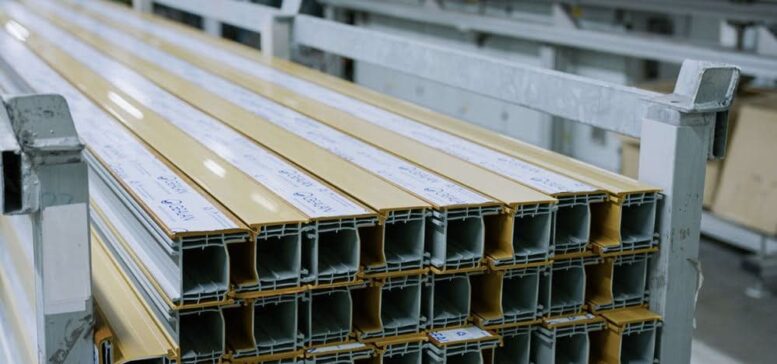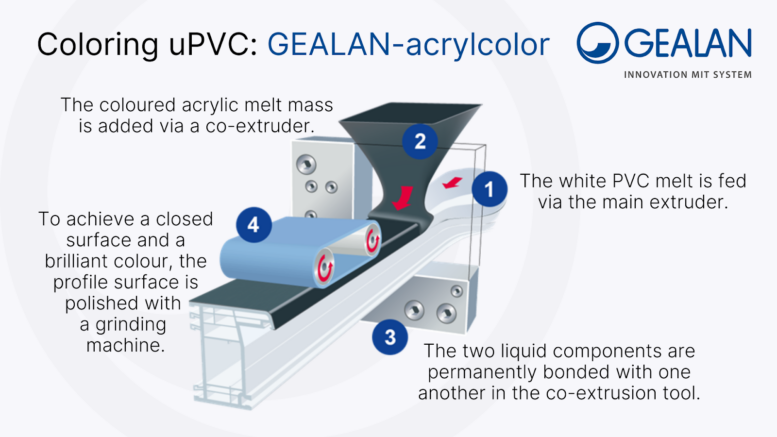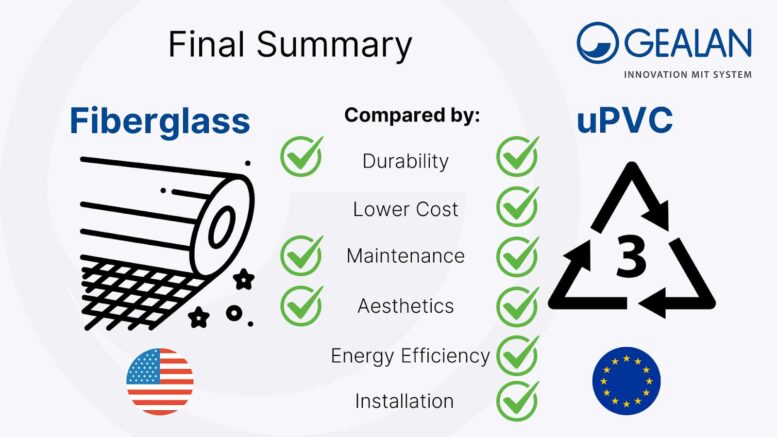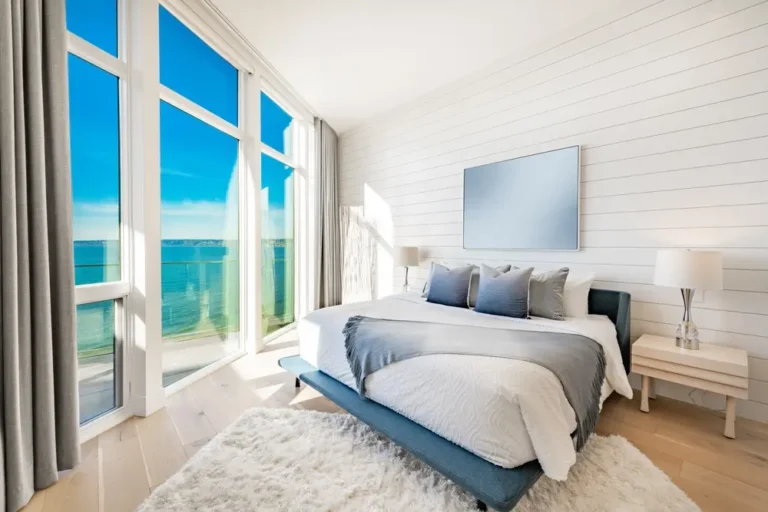Comparing Fiberglass vs Vinyl Windows (uPVC)
When replacing windows, many homeowners and builders face the decision between fiberglass and vinyl. Fiberglass is a favorite in the American market, celebrated for its durability and strength. Meanwhile, European uPVC vinyl stands out for its exceptional insulation, longevity, and cost-effectiveness. Which is the right choice for your home? Here, we’ll compare American fiberglass windows and European vinyl windows in terms of energy efficiency, durability, aesthetics, and more.
Key Differences Between Vinyl and Fiberglass Windows
Let’s look at the main differences between vinyl and fiberglass windows.
Material Composition and Strength

Fiberglass windows are manufactured using a pultrusion process, where glass fibers are pulled through resin to create rigid, weather-resistant frames. This method results in a material that’s strong and durable, capable of withstanding extreme conditions without warping or shrinking.
European vinyl windows, crafted from unplasticized polyvinyl chloride (uPVC), are made using an extrusion process. This material is free from plasticizers, giving it greater rigidity and resistance to wear over time. Unlike standard vinyl used in some American designs, uPVC resists rot, corrosion, and warping while maintaining excellent structural integrity. Many European vinyl windows also feature internal steel reinforcements, adding strength and ensuring long-term durability, even in demanding climates.
Insulation and Thermal Performance

When it comes to energy efficiency, both fiberglass and vinyl windows deliver solid results, but European vinyl (uPVC) edges ahead as the superior option. Vinyl is inherently more insulative than fiberglass, thanks to its low thermal conductivity, which naturally reduces heat transfer and keeps indoor temperatures stable.
Fiberglass, while still energy-efficient, depends more on its structural integrity and enhancements like low-emissivity (Low-E) glass coatings to achieve insulation. However, fiberglass frames don’t typically reach the thermal performance levels of multi-chambered vinyl designs.
Durability and Weather Resistance

Fiberglass windows are highly durable, with resistance to warping, shrinking, and expanding even in extreme climates. These windows maintain their structure and perform reliably in various weather conditions. This durability makes fiberglass windows a low-maintenance option, and their resilience to temperature fluctuations makes them a strong choice for regions with severe seasonal changes.
Vinyl windows typically perform well in diverse weather conditions as well, providing a long lifespan with minimal maintenance. However, vinyl can become brittle over time if exposed to extreme temperatures, especially older or low-quality vinyl types. The improved durability of European uPVC windows, however, makes them less susceptible to these issues, giving them a longer life expectancy compared to standard American vinyl.
A key advantage of European vinyl windows is their reinforced multi-chambered frames, strengthened with internal steel supports. These reinforcements enhance durability and prevent deformation over time, giving uPVC windows an edge over fiberglass in certain climates.
While fiberglass frames are inherently strong, their rigidity can sometimes be a drawback. Over time, natural house movements can create stress at rigid frame joints, particularly at the corners. This stress can lead to cracks, compromising the watertight seal and increasing the risk of leaks or mold. In contrast, uPVC frames offer slight flexibility, allowing them to adapt to structural shifts while maintaining a secure seal. This adaptability helps ensure that uPVC windows remain watertight and efficient, even as the house settles over the years.
Cost Comparison: Fiberglass vs Vinyl Windows (uPVC)
In general, fiberglass windows cost more than vinyl. This is partly due to the cost-intensive manufacturing process that includes binding glass fibers and resin into sturdy frames. While fiberglass windows can justify this cost with their durability and minimal maintenance, their upfront cost remains a consideration for budget-conscious buyers.
Vinyl windows, particularly European uPVC models, are a more budget-friendly option. Their lower initial cost, combined with long-term energy savings, makes them a smart investment. These windows offer excellent value for money, providing durability, efficiency, and affordability in one package. For homeowners seeking the perfect balance of quality and cost, uPVC windows are often the go-to choice.
Maintenance Requirements
One of fiberglass windows’ standout benefits is their minimal maintenance needs. They resist warping, rotting, and UV damage, maintaining their color and finish without requiring repainting. A simple occasional cleaning keeps them looking and performing their best.
Vinyl windows are similarly low-maintenance, particularly European uPVC windows, which are designed to resist discoloration and warping. They don’t require painting or sealing, making them convenient for busy homeowners. Regular cleaning is generally sufficient to maintain their appearance and performance.
Aesthetic Appeal and Design Options

Fiberglass windows deliver a sleek, modern aesthetic that complements various architectural styles. Their slim frames allow for larger glass panes, maximizing natural light and creating a high-end look. Fiberglass can even mimic the appearance of wood, offering elegance without the upkeep. However, its color options are often limited, and darker finishes typically come at an additional cost.
Meanwhile, vinyl window frames come in a range of colors and finishes, including wood-look options, that suit many home designs. Advanced finishes, like GEALAN-acrylcolor®, integrate acrylic glass into the frame for a durable, fade-resistant surface that retains its vibrancy over time. While vinyl frames aren’t as slim as fiberglass, their clean, minimalist lines pair seamlessly with contemporary architecture, providing excellent sightlines and plenty of light.

Installation Process
Fiberglass windows, due to their weight and rigidity, often require professional installation to ensure a proper fit. Their inflexibility demands precision, as improper installation can compromise seals and insulation. An experienced installer is essential to avoid potential issues.
Vinyl windows can be lighter and more forgiving, which can sometimes simplify the installation process. European uPVC windows are designed with advanced locking and sealing mechanisms that not only enhance performance but can also make installation straightforward. These features reduce the likelihood of errors, ensuring an airtight fit for optimal energy efficiency.
Environmental Impact
Fiberglass windows are often praised for their environmental benefits. The glass fibers used in fiberglass can be recycled, and the frames themselves are highly durable, reducing the need for replacements. However, the production process for fiberglass is energy-intensive, which can offset some of its eco-friendly advantages.
Another consideration with fiberglass is the health risk associated with cutting the material. Fiberglass dust is hazardous to inhale, posing potential cancer risks to workers. Vinyl windows, by contrast, require no hazardous cutting processes, making them a safer option in manufacturing.
uPVC windows are also recyclable, and many European manufacturers prioritize sustainable production practices. Additionally, the energy-efficient properties of uPVC windows help reduce overall energy consumption, which contributes positively to a home’s environmental footprint. For those focused on sustainability, vinyl windows offer a strong, eco-friendly option.
Noise Reduction
Fiberglass windows provide solid soundproofing, thanks to their sturdy frames and compatibility with double or triple-pane glass. This makes them a great choice for homes in noisy urban or high-traffic areas.
Vinyl windows, especially European uPVC designs, excel in noise reduction. Their multi-chambered frames help dampen sound, creating a quieter indoor environment. When paired with high-quality glazing, uPVC windows can transform any home into a peaceful retreat, making them an ideal option for noise-sensitive locations.
Vinyl vs Fiberglass Windows: Pros and Cons Summary

Let’s summarize the key points of difference.
- Durability: Fiberglass edges out vinyl in overall durability, but European uPVC offers enhanced resilience and longevity.
- Cost: European uPVC windows are more budget-friendly, delivering excellent performance without the premium price tag of fiberglass.
- Maintenance: Both require minimal upkeep, though fiberglass slightly outshines in long-term durability.
- Aesthetics: Fiberglass provides slim frames for a sleek, modern look, while vinyl excels in color variety and customizable finishes.
- Energy Efficiency: European uPVC windows often outperform fiberglass with superior insulation and multi-chambered designs.
So fiberglass windows may come at a higher price, but they don’t necessarily offer advantages over vinyl. In fact, uPVC windows often emerge as the better choice, providing superior energy efficiency, color options, and overall value.
Premium European Vinyl (uPVC) Windows in the US

While both fiberglass and vinyl windows bring unique benefits, European vinyl (uPVC) windows stand out as the top pick for homeowners seeking a cost-effective, energy-efficient, and stylish solution. With advanced insulation, weather-resistant materials, and modern aesthetics, uPVC windows strike the perfect balance between performance and affordability.
For those prioritizing energy efficiency and long-term value without a high upfront cost, European vinyl windows are a smart, sustainable investment that can enhance your home’s comfort and appeal.
At GEALAN we offer premium German-engineered uPVC window systems. Our GEALAN-LINEAR offers a sleek, minimalist design perfect for modern aesthetics, while our S 8000 system provides robust insulation and soundproofing, ideal for energy-conscious homes. Connect with GEALAN to find local suppliers for your project.
Table of Contents
FAQs
Why are vinyl windows generally more affordable than fiberglass windows?
Vinyl windows have a simpler production process and are lighter, making them less expensive to manufacture and install while still delivering excellent insulation.
Are fiberglass windows more durable than vinyl?
Fiberglass is exceptionally durable and resistant to warping or weathering. However, modern European uPVC windows offer comparable durability and often exceed expectations in demanding climates.
Are vinyl windows more energy-efficient than fiberglass?
Yes, European vinyl windows often outperform fiberglass in energy efficiency. Their multi-chambered frames provide better insulation, keeping your home comfortable and energy bills lower.
Do vinyl windows require much maintenance?
uPVC windows are virtually maintenance-free. A quick clean now and then is all that’s needed to keep them looking and performing at their best.
Which is better for resale value: fiberglass or vinyl windows?
Both materials can add resale value, but fiberglass may have a slight edge due to its premium perception. However, the affordability and efficiency of uPVC windows also make them an attractive option for many buyers.


